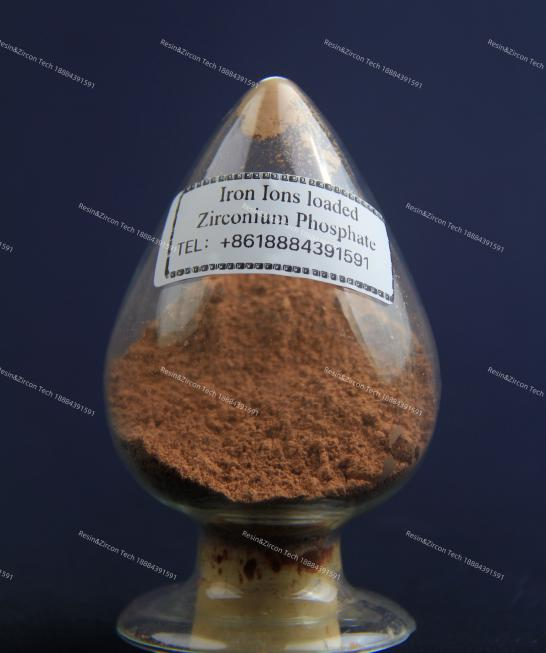Iron Loading with Zirconium Phosphate
Iron-loaded zirconium phosphate (ZrP-Fe) is a composite material that utilizes layered zirconium phosphate (ZrP) as the matrix and iron species (such as Fe³⁺, Fe₂O₃, FeO(OH)) as the active components. Its unique structure and properties have demonstrated significant application value in environmental remediation, catalysis, and functional materials. Understanding the material's mechanism remains crucial for comprehending its performance characteristics.

Application Area
-Heavy metal adsorption: Iron species (such as FeO (OH)) have strong coordination affinity for arsenic (As³⁺/As⁵⁺), chromium (Cr⁶⁺) and other heavy metals. The stability of the carrier ensures that the material can be regenerated by acid washing and reused more than 10 times, and the adsorption efficiency still remains above 80%.
-Organic pollutant degradation: As an heterogeneous Fenton catalyst, it can activate H₂O₂ to generate ·OH free radicals and degrade organic pollutants such as dyes (e.g., rhodamine B) and phenols (e.g., phenol). Compared with homogeneous Fenton (Fe²⁺ solution),
-Selective oxidation: catalyzes the oxidation of alcohols (e.g., benzyl alcohol) to aldehydes
-Denitration and desulfurization: · In flue gas treatment, iron species catalyzes NH₃ reduction of NOₓ (denitration) or O₂ oxidation of SO₂ (desulfurization). The high temperature resistance of zirconium phosphate (>300℃) ensures its stable operation in the high temperature environment of flue gas.
-Soil heavy metal fixation: By applying ZrP-Fe to contaminated soil, iron species and Pb²⁺, Cd²⁺ in the soil form stable precipitation, and the interlayer structure of zirconium phosphate can adsorb free heavy metal ions and reduce their bioavailability (for example, reducing the content of available Pb²⁺ in the soil by 60-70%).
-Remediation of organic contamination in groundwater: · Through the permeation reaction wall (PRB) technology, ZrP-Fe can continuously catalyze the degradation of chlorinated hydrocarbons (e.g., tetrachloroethylene) in groundwater, and the anti-washing property of the carrier ensures that the material is not lost in groundwater flow.
-Antibacterial: Iron species (especially Fe³+) can destroy bacterial cell membrane and inhibit the activity of respiratory enzymes, while the sustained release performance of zirconium phosphate enables the continuous release of iron ions to achieve long-term antibacterial effect (the inhibitory rate of Escherichia coli can reach 99%), which can be used for the surface coating of medical devices.
-Battery electrode materials: The oxidation-reduction activity of iron (Fe³⁺/Fe²⁺) combined with the ionic conductivity of zirconium phosphate can be used as a cathode material for lithium-ion batteries to improve the cycling stability.
1. Product features
-Improved stability: The layered skeleton of zirconium phosphate can limit the migration and agglomeration of iron species (especially for nanoparticles), and solve the problems of easy loss of pure iron oxide and rapid activity decay (for example, the loss rate of Fe³+ in heterogeneous catalysis can be reduced to less than 5%).
-Optimization of active sites: The surface hydroxyl groups of the carrier form coordination bonds with iron species to adjust the electron density of iron (e.g., making Fe³⁺ more easily reduced to Fe²⁺) and enhance its activity in REDOX reactions.
-Environmental adaptability expansion: Zirconium phosphate itself has the ability to buffer pH (interlayer H⁺ can adjust the pH of the system), so that iron species remain active in a wide range of pH (e.g., pH 3-9), which solves the limitation that pure iron species are only effective under acidic conditions.
2. Use advice
2.1 Advanced wastewater treatment (e.g., degradation of dyes and phenols): For wastewater with pollutant concentration of 10-100 mg/L, the addition amount of zirconium phosphate loaded iron is usually 0.1-5 g/L.
2.2 Organic synthesis catalysis (olefin oxidation, hydroxylation reaction): The amount of zirconium phosphate loaded iron is usually 1-10 mol% (in terms of iron molar quantity).
2.3 Heavy metal wastewater treatment (e.g., Pb²+, Cr⁶+, As³+): When the concentration of heavy metals in water is 1-50 mg/L, the dosage is usually 0.5-10 g/L.
2.4 Phosphorus removal (phosphate removal) in water: For the scenario of phosphorus concentration of 0.5-5 mg/L in water (such as sewage treatment plant effluent), the dosage is generally 0.5-3 g/L.
2.5 Paint/coating modification: the amount added is usually 0.5-5 wt%.
2.6 Plastic/rubber modification: the amount added is generally not more than 5 wt%.

Follow WeChat


